Benjamin Lay, Outspoken Quaker Abolitionist
The story of the abolition of slavery in America is a long and tortuous one. [1] Like many such stories it has its heroes and its villains. One group that almost always fell on the right side of history was the Society of Friends, better known as the Quakers. But that wasn’t always the case. When the Quakers first arrived in America, their members owned slaves just as all the other colonists did. A large part of making them realise the contradiction between their religious views and this practice was down to one of those heroes, the often forgotten Benjamin Lay.
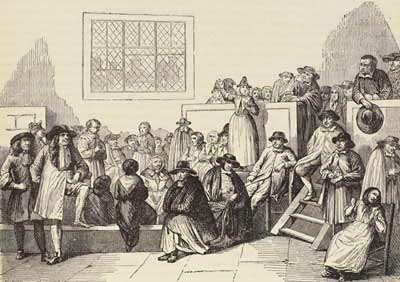
Benjamin Lay was born in the small village of Copford, Essex in 1682. His father William was a Quaker, though not an especially devout one, and his first wife came from outside the faith. His second wife, Benjamin’s mother Mary, was a Quaker. The family were reasonably well off, owning farmland and several buildings, but they did face persecution for being “dissenters”: members of a Protestant faith outside of the Church of England. Benjamin was a sickly child, and as he grew older it became clear that he had some form of congenital condition restricting his growth. It’s impossible to say for sure exactly what it was but the most likely candidate is “spondyloepiphyseal dysplasia congenita”; a form of dwarfism that is also associated with curvature of the spine. As an adult Benjamin stood four feet tall with a humped back, but he had a strength and agility that surprised many who met him.
In his teens Benjamin went to work on the farm of his elder half-brother William, who like his mother was not a Quaker. Despite this Benjamin got on well with him and his family, including his young nephews and nieces. He was a shepherd, a job he enjoyed and one which would influence his language for the rest of his life. As he grew old enough to take on a trade of his own his father sent him to Colchester after arranging for an apprenticeship with a glover there. Benjamin liked this much less than being a shepherd, so in 1703 at the age of 21 he decided to run away to London to become a sailor.
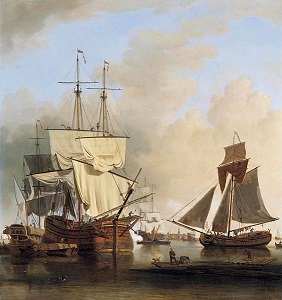
Benjamin spent a dozen years as a sailor, years that shaped him and his outlook for the rest of his life. In a time when many people barely moved more than a hundred miles from their birthplace in a lifetime, Benjamin traveled the world and saw dozens of countries and peoples. This bred in him a tolerance that was absent from many of his peers. Though his stature was never a disadvantage to him at sea, he still identified more with the downtrodden than their oppressors, and was generally horrified by the tales he heard of the slave trade. As a result he never worked on such a ship, or counted as friend one who had. He probably learned to read while he was at sea, as despite common stereotypes sailors were often literate and voracious readers. Benjamin didn’t receive much schooling growing up but he would become extremely well-read as an adult.
Benjamin lodged in London between voyages, where he met a young woman named Sarah Smith. Like him, she was a Quaker, and like him, she was a dwarf. Sarah was born in 1677 in Rochester but her family moved to Deptford when she was a child. They were not Quakers, but she converted in her youth and soon became widely respected for her devotion and her intelligence. By 1712 she was a minister of the congregation and traveled to represent them in meetings with other congregations. She was most often in the Meeting House of the Deptford Quakers though and that is probably where she met Benjamin, as it sat on the Thames in the heart of the shipyards and sailor’s lodgings. Benjamin was smitten, and spent five years courting her. During this time he left the sailor’s trade and found work as a glover in London. In 1717 she agreed to marry him.
Marriage wasn’t that straightforward, though. As a Quaker he needed a certificate declaring his eligibility for marriage from his own meeting house (the Devonshire House Monthly Meeting in London). He didn’t have any of the disqualifying conditions; he was neither already married nor in debt. But his opinionated mind, and his willingness to speak those opinions, had made him enemies of ministers in the meeting house that he had argued with. So he decided to think laterally, and took a job on a ship heading to the British colony of Massachusetts. There he asked the local meeting house to give him a certificate. They wrote to London, and though they did agree that the certificate should be issued they asked for it to include a passage exhorting him to “lowliness of mind” and to behave himself peaceably in church. Of course Benjamin didn’t do this, and so they refused to give him the official copy of the marriage certificate from Massachusetts. Benjamin had to appeal to the London Quarterly Meeting, a committee overseeing all the Quakers in the city, for assistance. They condemned his conduct but agreed that the DHMM should not withhold the certificate. So finally in July of 1718 he and Sarah were married. Two months later, with tensions still lingering, they left London and moved to Barbados.
Benjamin and Sarah set up shop on the wharf in Bridgetown, the capital of Barbados. They sold general goods and business went well, but there was a dark undercurrent to the island that soon began to tell on the pair. The primary business in Barbados was sugar-farming, and sugar-farming was both back-breaking and deadly dangerous work. But it brought huge profits. The simple solution practiced by the planters of Barbados was slave labour, people captured in war or kidnapped in Africa and sold onto ships to come across the ocean and toil and die under the merciless Barbados sun. Life expectancy for slaves was short, but the planters didn’t mind. If a slave survived a year in the plantations he had done enough to cover his purchase, and anything after that was profit. The sugar shipped over to the table of Europe was created from a rich wellspring of human misery, with workplace fatalities from injuries or fatal scalding a daily occurrence. As Benjamin put it, “sugar was made with blood”.
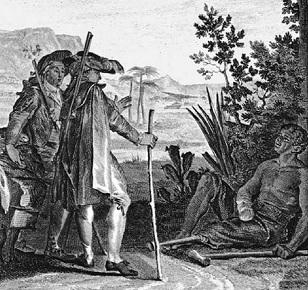
Benjamin and Sarah soon began to see more and more the cruelty that Barbados was built on. Benjamin used to encourage the slaves who came into the store to tell him their stories, and all were of being beaten and whipped for the slightest transgression; or even for no reason at all in order to teach them “their place”. When Sarah went to visit a fellow Quaker, she was horrified to find a slave hung in chains outside the man’s house who had been whipped so severely that a pool of blood was on the ground beneath him. She was even more horrified to find that the Quaker, allegedly a follower of her own religion, answered her question about the man by going on a tirade about the slave’s ingratitude.
After a few months Benjamin and Sarah began to take action. They started holding prayer meetings at their homes for the slaves, where they served meals to the starving workers. They began preaching against the practice of slavery, something which led the masters to forbid their slaves to go. Nonetheless hundreds still did. The ruling class of the island eventually began moves to banish them for “fraternization”, but Benjamin and Sarah preempted them by returning to London in the spring of 1720. They had only been in Barbados for a year and a half, but the things they had seen there would stay with them and drive them for the rest of their lives.
Back in London it wasn’t long before Benjamin began getting into arguments with his fellow Quakers again. He wound up being expelled from the Devonshire House Monthly Meeting, though he ignored this for as long as he could get away with it. Eventually he and Sarah moved back to Colchester, where he found refuge with a Meeting House that was almost as radical as him. The Colchester Monthly Meeting (to which his parents had also belonged) was one of the few houses to hold to the old tradition of having a single meeting for both men and women; something which Benjamin heartily endorsed. (In fact, his belief that men and women were equal in the sight of God was the source of more than one of his disputes.) Sarah managed to remain untainted by her husband’s controversy, and continued to be a deeply respected minister who often travelled widely around the country (leaving him at home on his own). In 1730 they decided to emigrate to America, though this did require them to have a letter from the English Quakers that would allow them to join an American meeting house. It took over a year for them to get the other houses to agree to let the CMM grant them one, but eventually they did. In March 1732 they set off for Philadelphia.
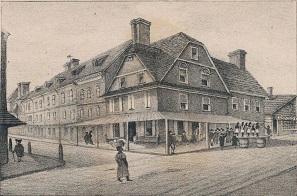
Benjamin’s trade in Philadelphia was as a bookseller, something driven both by his own love of books and by his belief in the value of education for a community. His belief in that community itself was shaken, though, when he discovered that here as in Barbados there were many Quakers, prominent men seen as leaders, who were perfectly happy to own slaves. He did find one sympathetic friend though: Ralph Sandiford, an immigrant from Liverpool who was like him an ex-sailor. Ralph was a man after Benjamin’s own heart; he had gotten into trouble with the Quaker elders in 1729 when he published an anti-slavery book called A Brief Examination of the Practice of the Times after they had forbidden him to. The persecution he had received as a result of this had given him a nervous breakdown, and he was in very poor health when Benjamin met him. He died in May of 1733 aged only forty years old. The fact that the “good men” of the community continued to disparage him after his death enraged Benjamin, and it let him know what he would be in for when he went against them.
Benjamin soon became notorious in Philadelphia for his general demeanor and his opposition to slavery in particular. One notable tactic he would take in meetings was that whenever a slave-owner rose to speak Benjamin would immediately interrupt him to denounce him for his sin. On another occasion he walked out of a meal with a gentleman “of considerable note” when he found out that the man owned slaves. And this was also when he began his theatrical protests against slavery, throwing clay tobacco pipes to the ground in meetings in protest of the slave labour on tobacco plantations. On another he arrived at a meeting in the snow wearing no shoe on his right foot but walking barefoot in the snow. When anyone expressed any concern at this, he then told them that they should be just as concerned for the slaves forced to work outside all winter in inadequate clothing, quoting Matthew to back up his point.

Given the persecution from senior slave-owning Quakers (in particular Robert Jordan Jr, a tobacco magnate from a long line of slave-owners), Benjamin and Sarah decided to move outside of Philadelphia and into the nearby village of Abington. This was also prompted by the fact that Abington was home to one of Sarah’s dearest friends, a Quaker missionary named Susanna Morris. The pair had become friends on the missionary trail and had then formed a deep bond when they both survived a shipwreck during a voyage to Amsterdam in the 1720s. The Morris family were steadfast friends of the Lays and were a strong support to Benjamin in the years that followed; a support that he soon needed when Sarah suddenly died in 1735.
It’s easy to forget, given her less confrontational manner, but Sarah was just as committed an abolitionist as her husband and arguably, in her role as missionary, a more influential one. She was fiercely intelligent and charismatic, and spent her life teaching people about what she thought was right and wrong. Her compassion had tempered his anger, and she was the one who had driven their attempts to enrich the slaves of Bridgetown. Her death was devastating to Benjamin, not least because he had assumed that she (whose health was generally better) would outlive him. It was six months after her death that Benjamin began work on the book that would be his legacy; perhaps he missed his conversations with Sarah and decided to start a conversation with the world.
Without Sarah’s calming influence, Benjamin’s confrontations with the rich Quaker slaveowners of Philadelphia became more pronounced. In addition to Robert Jordan he also came into bitter conflict with Ralph Morris, a Quaker who had actually been responsible for drawing up Pennsylvania’s Slave Code ten years earlier. [2] As a result of this he was officially denied membership in the Pennsylvania Monthly Meeting, and eventually in the Abington Monthly Meeting as well. For his part, Benjamin constantly raised motions saying that slave-owners were unfitted to preach or speak in meetings and condemned them in no uncertain terms:
For Friends, all you that are Ministers of Anti-Christ, whether in Pulpits or in Galleries, you that are of the Royal Offspring, of the King of the Locusts, and are creeping out of the Bottomless Pit a little, to see what Mischief you can do to Mankind , & Service for your King Lucifer, who was (and is now to you) as the Son of the Morning, and to see what good you can get for your God, your Bellies.
While this conflict was going on, Benjamin continued work on his book: All Slave-Keepers That Keep The Innocent In Bondage. This was one of the first anti-slavery books ever published in North America, and it was printed for Benjamin by Ben Franklin in 1738. Franklin was himself struggling with moral qualms over slavery at the time, and though he had not yet made up his mind on the issue he was impressed by Benjamin’s conviction. The two Benjamins struck up a lifetime friendship, and later on (when he had come down on the abolitionist side) Franklin would be deeply proud of having published this book.
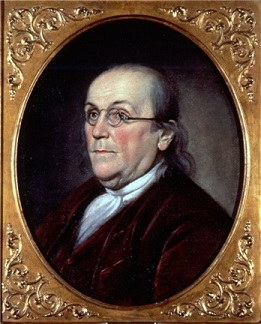
The book itself was no great feat of writing skill, as Benjamin himself was first to admit. In fact he gave himself up to Franklin completely to edit it, and that may be why it has the coherence that it does. The content, though, was explosive. Slavery was the great hypocrisy at the heart of the American self-image, and few had put it into the public debate quite as forcefully as Benjamin did. He opened by reaffirming his Quaker beliefs, and stating that his aim was to provide a service to that community. That service was to lay bare the contradiction between their beliefs and actions, and in that he succeeded. Over the next few years the issue of slavery would become more and more of a tension within the Quaker community, though that may be as much due to his actions as to his writings.
Benjamin’s book also documented the abuse of slaves that he had seen throughout his life, from Barbados to Philadelphia. He spoke of those he had seen who opposed slavery, and laid out his theological justifications for declaring it a great sin. His goal was to mobilize those Quakers who opposed slavery but were reluctant to speak out, and to convert those who supported slavery but did not own any (or many) slaves. The “great men” of the community he had already written off as irredeemable. It was the younger generation to which he turned, and many of the great abolitionist figures of the 18th century were those who had been personally gifted a copy of his book by Benjamin. In his travels around the colonies, he also made sure that those he met knew who else shared their beliefs, building a movement within the Quaker faith to effect a change. He knew that this change had to come from the bottom up, and that this would need numbers.
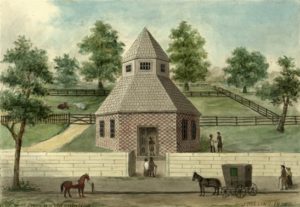
A century after this, the anarchist Mikhail Bakunin would write about the idea of “propaganda of the deed”. Ironically given Bakunin’s political leanings this idea came in many ways from religion, where actions often served to inspire where words cannot. Benjamin’s “moneychangers in the temple” moment came later in 1738, six months after his book was published. The Philadelphia Monthly Meeting held their Yearly Meeting in Burlington, New Jersey – thirty miles from Abington. He waited until he had a chance to speak, and then stood up. In his deep voice (which always surprised people, given his size) he declared that God held all peoples equal, and that slavery was the greatest evil in the world. Then he threw off his coat, revealing a military uniform with a sword belted at the side. He drew the sword and stabbed the book, shouting
Thus shall God shed the blood of those who enslave their fellow creatures!
Blood did indeed shoot out of the book, spattering those around him. (Actually it was pokeberry juice. He had hollowed out the book and hidden a full bladder of it within it.) The room exploded in confusion. Benjamin was physically removed, but there was no way to remove the impression he had left. And slavery, despite what some might have wished, was now firmly on the agenda.
Following on from his appearance in the PMM’s annual meeting, Benjamin faced consequences. One of those “eminent men” present was John Kinsey, speaker of the Pennsylvania House of Representatives, attorney-general of Pennsylvania and de-facto head of the Quaker faith in the colonies. The Quaker faith did not have formal leaders, and Kinsey was the most powerful of the leaders that they did not have in America. Of course, he was also a slave-owner. Benjamin had called him out personally in his book, and unsurprisingly Kinsey struck back. He was the head of the Board of Overseers, whose purpose was to pass judgment on books written by Quakers and to verify that they conformed to the faith. Naturally he declared that Benjamin’s book did not, and he went further to declare that “the Author is not of their religious Community”. Officially then Benjamin was no longer a Quaker, and would never be one again.
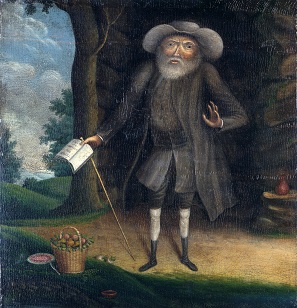
Benjamin’s belief in freedom from bondage extended to the bondage of animals, though he did not push that belief as forcefully on others. Nowadays he would be classed as a vegan, as he neither used nor consumed any animal products. He also made his own clothes, since he believed that the capitalist system of the Colonies was intrinsically tied to slave labour. His enemies often mocked him for “living in a cave”, though this was more common than you might think. In fact his home was quite comfortable and would have been the envy of many of them if they had known it. The only known painting of him shows him standing in front of that cave. It was done without his knowledge (and he would probably have objected to it if he’d known); commissioned by Ben Franklin’s wife as a present for her husband to commemorate this warrior against slavery.
Benjamin’s chief philosophical inspiration was Diogenes, the Cynic philosopher who had made his life into a parable of humility. Though Benjamin read all the classical philosophy that he could, it was Diogenes who stuck with him and who in part became a model for the life he led. Both lived without pretension, and both were utterly unafraid to speak truth to power. That Diogenes was a former slave was the icing on the cake. It was Ben Franklin who dubbed Benjamin a “Cynic philosopher”, prompted by one of Benjamin’s public display in 1742. At a market in Philadelphia he set up a table, arranged on it a set of beautiful china teacups (formerly owned by Sarah) and began to smash them in protest at the treatment of those who harvest tea and produced sugar. A crowd soon gathered in protest, declaring that he should not destroy the teacups and should give them to him instead. Eventually he was rushed by a mob who carried him off and stole the remaining crockery, proving his point: that society valued property more than it valued human freedom.
One of Benjamin’s most infamous (and possibly apocryphal) acts of protest involved a Quaker family who had a young black girl as a slave. They also had a young son, who Benjamin convinced to come with him from their house and play in his cave. The boy had a grand time running around in there, while Benjamin just sat at the door and waited. Eventually he saw the boy’s parents coming running down the road in great distress. He asked them what was wrong, and they told him their son had been missing all day and they were greatly afraid for his safety. Benjamin replied:
Your child is safe in my house, and you may now conceive of the sorrow you inflict upon the parents of the negro girl you hold in slavery, for she was torn from them by avarice.
Despite his hard lifestyle and the worries he had about his health in his forties, Benjamin survived well into his seventies. Up until the age of 75 he was still travelling around the colonies on foot meeting with abolitionists and protesting slave holders, but that was when his health finally began to give out. He spent the last two years of his life living in his cave, with visitors now coming to him rather than the other way round. In 1758 one of those visitors brought him some news that brought him a huge amount of joy. The Philadelphia Yearly Meeting had voted, against the wishes of its leadership, and had ruled that any Quaker who traded in slaves would be disciplined and eventually disowned. Slave ownership was still permitted (and would be until 1776) but it was the first official Quaker ruling that recognized the immorality of slavery. Benjamin was ecstatic at the news, and declared that “Now, I can die in peace.” In February of 1759, after a brief illness, he did.
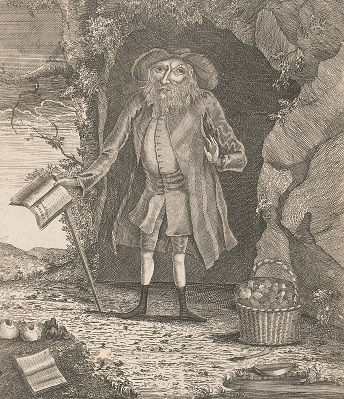
In his final years Benjamin had asked one friend if he would cremate him and scatter his ashes at sea, but this was far from a social norm at the time and the friend refused. So he was buried (as was traditional) in an unmarked grave near Sarah’s in the Quaker graveyard in Abington. His friends had an engraving made to remember him by, based on the portrait by Williams Williams. The engraving proved popular and sold well, often being hung in houses as an unobtrusive statement of support for abolition. Unobtrusive because the engraving contained no overt reference to Benjamin’s abolitionist views – at least at first. When a copy of the engraving was made in 1815 to accompany Roberts Vaux’s Memoirs of the Lives of Benjamin Lay and Ralph Sandiford (originally relased in 1790, and re-released that year) the title of the book in Benjamin’s hand was changed from Trion On Happiness [3] to African Emancipation, openly acknowledging Benjamin’s once-controversial views at last.
Despite that biography in 1815, and despite his high-profile friends like Franklin, Benjamin Lay was for many years relegated to a footnote in the history of American abolitionism. He wasn’t an easy man to turn into a saint, as many abolitionist heroes were (or at least had their history written to make them). He was a forthright man, who didn’t temper his opinions to make them easy to swallow. He was physically abnormal, and thus not worthy of serious consideration by deeply ableist historians. He was lower class, a sailor and merchant, not one of the “great men” who think they run the world. He was an agitator against authority, something which Americans have never taken to kindly. More to the point though, it suited the authorities to push a narrative of enlightened elders leading the Quaker faith into its abolitionist viewpoint. It wasn’t until the 1980s that historians began to point out that the reason these elders could make these advances in the 1750 and 1760s was due to the grassroots activism of Benjamin and those like him in the 1730s and 1740s. And only in recent years has he begun to receive the attention he deserves (most notably in Marcus Rediker’s excellent autobiography). In 2017 the Abington Monthly Meeting officially recognised that Benjamin had been right, and that he should not have been expelled from their community. In 2018 they put up a memorial to him and Sarah in their graveyard.
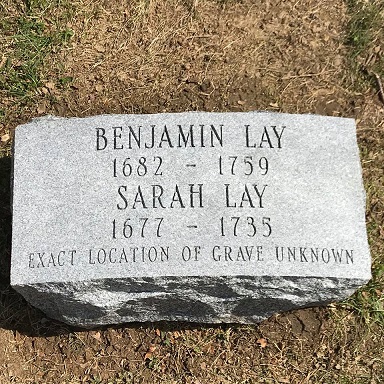
Nowadays Benjamin Lay still remains an obscure figure, but he should be remembered as one of the few Americans of his generation that recognised and refused to compromise with the evil that lay at the heart of their society. Benjamin made his own life into a parable. He knew that people would tell stories of the apparently crazy things he did, and he knew that through this the moral lesson he was teaching would spread. And while he preached a love for all mankind, he recognized that there was no contradiction between that and refusing to compromise with those who drew their wealth from human suffering. He was, in many ways, a man ahead of his time. But in many other ways he was exactly the man his time needed, and the world today would be a worse place if he had not been in it. For that, we should be grateful.
Pictures via wikimedia except where stated.
[1] And one that arguably isn’t over yet.
[2] Like most such codes, it didn’t just regulate the treatment of slaves but also banned interracial marriage and imposed restrictions on free black people, with enslavement as a legal punishment for them if they offended social norms. It also notably set out a law that the state should compensate any slaveowner who had to execute a slave for “rebelliousness”.
[3] A misspelling of Thomas Tryon’s name and a reference to his book A Way to Health, Long Life and Happiness. Tryon was an early English abolitionist who like Benjamin had been turned against the slave trade by what he had seen working in Barbados. His book (in which he advocated for vegetarianism) was a favourite of both Benjamin Lay and of Ben Franklin; and in one edition had a foreword by Aphra Behn.
